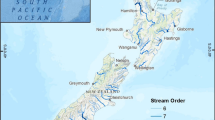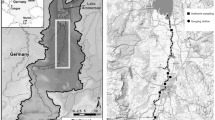Abstract
Since about 90% of the natural floodplain area of rivers in Europe has been reclaimed and now lacks river dynamics, nature rehabilitation along rivers is of crucial importance for the restoration of their natural function. Flood protection, self-purification of surface water, groundwater recharge, species protection and migration are all involved in this process. It is now generally recognised that rivers form natural arteries in Europe but are also of economic importance and are recognisable cultural landscape. Many examples are already available of successful small river restoration projects. Several species thought to be extinct have now reappeared and characteristic species have also expanded in recent years. This paper concentrates on the concept of setting targets for river restoration as exemplified by the Meuse River. A modelling exercise shows the restraints of current habitat configuration and the potential for habitat restoration along the river. A policy analysis, using a strategic approach, illustrates the influence of the decision making process on the targets for natural river development. River dynamics play a key factor in determining the potential for persistent populations of target animal species along the river, with the help of an expert system (LARCH, Landscape ecological Analysis and Rules for the Configuration of Habitat). The potentials for the increase of dispersion and biodiversity and the maximisation of ecological benefits at different scales, are also considered.
Similar content being viewed by others
References
Amoros C. and Petts G.E. (eds) 1993. Hydrosystèmes Fluviaux. Macon, Paris.
Anonymous 1994. Natur 2000 in Nordrhein-Westfalen. Leitlinien und Leitbilder für Natur und Landschaft. Ministerium für Umwelt, Raumordnung und Landwirtschaft des Landes Nordrhein-Westfalen, Dortmund, Germany.
Arbeitsgemeinschaft Renaturierung Hochrhein 1996. Hochrhein Fachtagung 'Lebendiger Hochrhein'. Beiträge zur Umsetzung des Aktionsprogramms 'Rhein 2000'. Arbeitsgemeinschaft Renaturierung des Hochrheins, Basel, Switzerland.
Bayley P.B. 1991. The flood pulse advantage and the restoration of river-floodplain systems. Regul. Rivers Res. Man. 6: 75-86.
Billen G., Décamps H., Garnier J., Boët P., Meybeck M., and Servais P. 1995. Atlantic river systems of Europe. In: C.E. Cushing, K.W. Cummins and G.W. Minshall (eds), River and Stream Ecosystems. Ecosystems of the world 22, Elsevier, Amsterdam, The Netherlands, pp. 389-418.
Boon P.J. 1992. Essential Elements in the Case for River Conservation. In: P.J. Boon, P. Calow and G.E. Petts (eds), River Conservation and Management, Wiley, Chichester, UK, pp. 11-33.
Cals M.J.R., Postma R., Buijse A.D., and Marteijn E.C.L. 1998. Habitat restoration along the River Rhine in The Netherlands: Putting ideas into practice. Aquat. Conserv. Mar. Freshw. Ecosyst. 8: 61-70.
Chardon J.P., Foppen R.P.B., and Geilen N. 2000. LARCH-RIVER, a method to assess the functioning of rivers as ecological networks. Europ. Water Manag. 3(6): 35-43.
Dahm C.N., Cummins K.W., Valett H.M., and Coleman R.L. 1995. An ecosystem View of the Restoration of the Kissimmee River. Restor. Ecol. 3: 225-238.
De Blust G., Froment A., Kuijken E., Nef L., and Verheyen R. 1985. Biologische waarderingskaart van België. Algemene verklarende tekst. IHE, Brussel, Belgium.
Foppen R.P.B. and Reijnen R. 1998. Ecological networks in riparian systems. Examples for Dutch floodplain rivers. In: P.H.Nienhuis, R.S.E.W. Leuven and A.M.J. Rages (eds), New Concepts for Sustainable Management of River Basins. Backhuys Publishers, Leiden, The Netherlands, pp. 85-94.
Forman R.T.T. 1995. Land Mosaics. The Ecology of Landscapes and Regions. Cambridge University Press, Cambridge, UK.
Galloway G.E. 2000. Three centuries of river management along the Mississippi river: engineering and hydrological aspects. In: A.J.M. Smits, P.H. Nienhuis and R.S.E.W. Leuven (eds), New Approaches to River Management, Backhuys Publishers, Leiden, The Netherlands, pp. 51-64.
Gore J.A. (ed.) 1985. The Restoration of Rivers and Streams: Theories and Experience. Butterworths/Ann Arbor, Michigan, USA.
Havinga H. and Smits A.J.M. 2000. River management along the Rhine: A retrospective view. In: A.J.M. Smits, P.H. Nienhuis and R.S.E.W. Leuven (eds), New Approaches to River Management, Backhuys Publishers, Leiden, The Netherlands, pp. 15-32.
Junk W.J., Bayley P.B. and Sparks, R.E. 1989. The flood-pulse concept in river-floodplain systems. Spec. Publ. Can. J. Fish. Aquat. Sci. 106: 110-127.
Kern K. 1992. Rehabilitation of Streams in South-west Germany. In: P.J. Boon, P. Calow and G.E. Petts (eds), River Conservation and Management, Wiley, Chichester, UK, pp. 321-335.
Lenders H.J.R., Aarts B.G.W., Strijbosch H., and Van der Velde G. 1998. The role of reference and target images in ecological recovery of river systems: Lines of thought in The Netherlands. In: P.H. Nienhuis, R.S.E.W. Leuven and A.M.J. Ragas (eds), New Concepts for Sustainable Management of River Basins, Backhuys Publishers, Leiden, The Netherlands, pp. 35-52.
Lorenz C.M., Van Dijk G.M., Van Hattum A.G.M., and W.P. Cofino 1997. Concepts in river ecology: Implications for indicator development. Regul. Rivers Res. Man. 13: 501-516.
Pedroli B. 1999. The Nature of Lowland Rivers: A Search for River Identity. In: J.A. Wiens and M.R. Moss (eds), Issues in Landscape Ecology, International Association for Landscape Ecology/University Guelph. Guelph, Canada, pp. 103-111.
Pedroli G.B.M. and Postma R. 1998: Nature rehabilitation in European river ecosystems. Three cases. In: P.H. Nienhuis, R.S.E.W. Leuven and A.M.J. Rages (eds), New Concepts for Sustainable Management of River Basins, Backhuys Publishers, Leiden, The Netherlands, pp. 67-84.
Pedroli B., Postma R., Rademakers J., and Kerkhofs S. 1996. Welke natuur hoort er bij de rivier? Naar een natuurstreefbeeld afgeleid van karakteristieke fenomenen van het rivierlandschap. Landschap 13: 97-113.
Petts G. 1990. Water, engineering and landscape: development, protection and restoration. In: D. Cosgrove and G. Petts (eds), Water, Engineering and Landscape. Water Control and Landscape Transformation in the Modern Period, Belhaven Press, London/New York, NY, USA, pp. 188-208.
Petts G.E. and Amoros C. 1996. The Fluvial Hydrosystem. Chapman and Hall, London, UK.
Petts G.E. and Bradley C. 1997. Hydrological and Ecological Interactions within River Corridors. In: R.L. Wilby (ed), Contemporary Hydrology, Towards Holistic Environmental Science. Wiley, Chichester, UK, pp. 241-271.
Reijnen R., Harms W.B., Foppen R.P.B., de Visser R., and Wolfert H.P. (1995). Rhine-Econet. Ecological Networks in River Rehabilitation Scenarios: A Case Study for the Lower Rhine. Publications and reports of the project 'Ecological Rehabilitation of the Rivers Rhine and Meuse' No. 58-1995. RIZA, Institute for InlandWaterManagement andWasteWater Treatment, Lelystad, The Netherlands.
Schama S. 1995. Landscape and Memory. HarperCollins, London, UK.
Statzner B. and Higler B. 1986. Stream hydraulics as a major determinant of benthic invertebrate zonation patterns. Freshwater Biol. 16: 127-139.
Vanacker S., Van Looy K., and De Blust G. 1998. Typologie en habitatmodellering van de oevers van de Grensmaas. Rapport Instituut voor Natuurbehoud 98.4, Brussel, Belgium.
Van der Kraats J.A. (ed.) 1994. Rehabilitation of the River Rhine. Water Science & Technology, Special Issue: Proceedings of the International Conference on Rehabilitation of the River Rhine 15-19 March 1993, Arnhem, The Netherlands. ]
Van de Ven G.P. (ed.) 1993. Man-made Lowlands. History of water management and land reclamation in the Netherlands. Matrijs, Utrecht.
Van Looy K. and De Blust G. 1995. De Maas natuurlijk?! Aanzet tot een grootschalig natuurontwikkelingsproject in de Grensmaasvallei. Wetenschappelijke Mededelingen van het Instituut voor Natuurbehoud 1995 (2), Brussels, Belgium.
Van Looy K. and Kurstjens G. 1997. Kerkeweerd: doorkijk naar de natuurontwikkeling langs de Grensmaas. Natuurhistorisch Maandblad 86: 155-159.
Vannote R.L., Minshall G.W., Cummins K.W., Sedell J.R., and Cushing C.E. 1980. The River Continuum Concept. Can. J. Fish. Aquat. Sci. 37: 130-137.
Verboom J., Foppen R., Chardon P., Opdam P., and Luttikhuizen P. 2001. Introducing the key patch approach for habitat networks with persistent populations: An example for marshland birds. Biol. Conserv. 100: 89-101.
Vos C.C., Verboom J., Opdam P.F.M., and Ter Braak C.J.F. 2001. Toward ecologically scaled landscape indices. Am. Naturalist 157: 24-41.
Ward J.V. 1989. The four-dimensional nature of lotic ecosystems. J. North Am. Benthol. Soc. 8: 2-8.
Author information
Authors and Affiliations
Rights and permissions
About this article
Cite this article
Pedroli, B., de Blust, G., van Looy, K. et al. Setting targets in strategies for river restoration. Landscape Ecology 17 (Suppl 1), 5–18 (2002). https://doi.org/10.1023/A:1015221425315
Issue Date:
DOI: https://doi.org/10.1023/A:1015221425315




